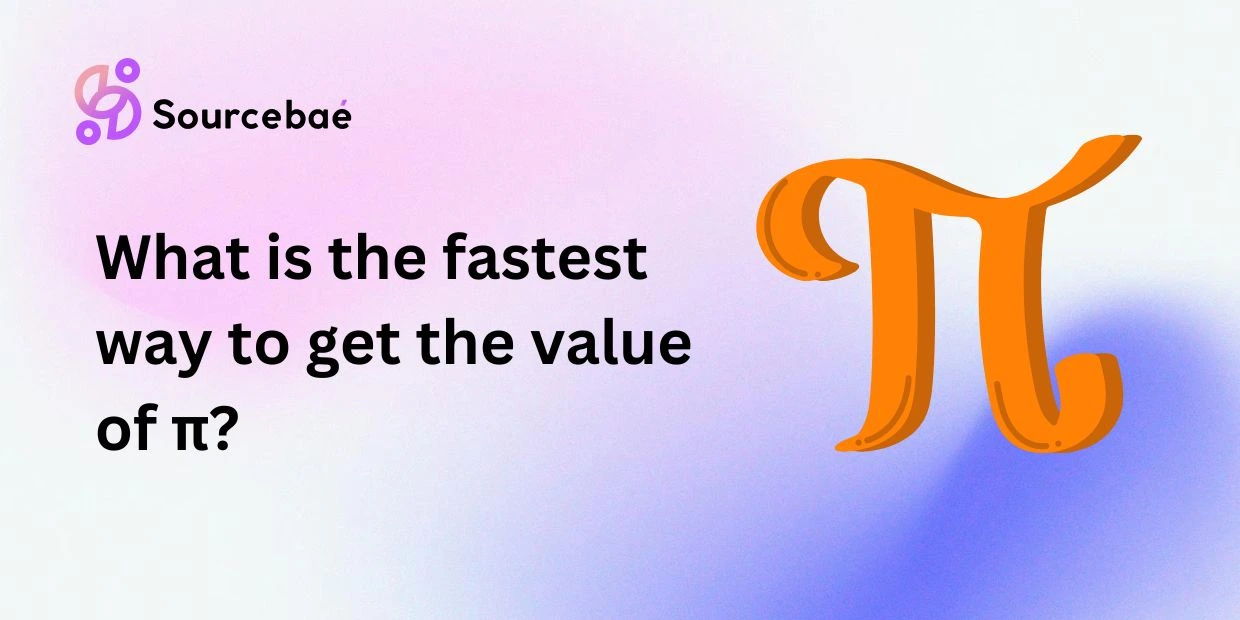π, or Pi, is among the most fascinating constants in all mathematics, recognized worldwide and celebrated every March 14 (3/14). Understanding π has been an intellectual pursuit for thousands of years, playing an essential role in mathematics, physics, architecture, engineering, and even astronomy. Simply stated, value of π represents the ratio of a circle’s circumference to its diameter—never changing, no matter what circle you utilize.
Yet despite its simplicity, π is famously elusive in terms of finding a precise and finite decimal representation. Throughout history, mathematicians have dedicated entire lifetimes aiming for better and faster ways to approximate π. Today, quick and accurate calculation techniques continue evolving, thanks mostly to computational advancements. But if you are looking for the fastest way to find π right away, in real-world practical scenarios, what exactly should you do?
Let’s explore why π matters, examine historical efforts, investigate modern computational approaches, and finally answer the big question: what is the absolute fastest way to get the value of π?
What Is π and Why Is It Important?
Defining π Clearly: What Exactly is π?
Simply speaking, π (Pi) is the ratio of a circle’s circumference to its diameter. This relationship holds universally true irrespective of the circle’s size, an intriguing mathematical truth discovered thousands of years ago.
Historical Context: Humanity and π
Human fascination with π is ancient, dating back thousands of years. Ancient civilizations like Egyptians and Babylonians had approximate theories to measure circles, while Archimedes significantly advanced π approximations through geometric methods. Historical mathematicians constantly refined these calculations—but never with absolute precision.
Why π has Infinite Digits Without Patterns
The number π is irrational, meaning it cannot be precisely expressed as a simple fraction or ratio of integers. Consequently, π’s decimal representation extends infinitely without noticeable repeating patterns or periodicity, making exact calculation impossible and necessitating numerical approximations.
Applications of π in Daily Life
π is ubiquitous—beyond simple circle calculations. Today, its role extends deeply into real-world scenarios including:
- Architecture: precise measurement and structural integrity calculations.
- Engineering and physics: crucial for design, rotations, trajectories, and oscillations.
- Space exploration: planetary movement calculations and precise spacecraft mission trajectories depend heavily on accurate π approximations.
Traditional Methods for Calculating π
Early Approaches: How Did We Start Calculating π?
Historically, methods for approximating π ranged widely:
- Archimedes and polygons (Ancient Greece): Archimedes famously approximated π by inscribing and circumscribing polygons around a circle.
- Leibniz infinite series: Gottfried Leibniz’s series (π/4 = 1 – 1/3 + 1/5 – 1/7…) was revolutionary but extremely slow to converge.
Traditional Method Limitations
These classical mathematical approaches shared notable limitations. While they contributed greatly to mathematical knowledge, they were typically characterized by:
- Slow convergence rate: requiring considerable calculations for high accuracy.
- Inefficient implementation: traditional numerical series posed practical limitations.
Modern Computational Techniques (Fastest Ways to Calculate π)
Modern computing breakthroughs revolutionized our understanding of π calculation. Today, modern techniques, aided by computers, rapidly provide astonishing accuracy:
Monte Carlo Simulations (Probabilistic Algorithm)
Monte Carlo simulations generate random points inside a square containing a circle to probabilistically estimate π. With a sufficient number of samples, this method converges toward an accurate approximation. Although very intuitive and educationally valuable, it demands significant computational resources for precise results.
Ramanujan’s Formula: Rapidly Converging Series
The Indian mathematical genius Srinivasa Ramanujan provided a surprisingly efficient formula for swiftly estimating π, rapidly converging towards high accuracy in fewer steps than traditional series approaches. Ramanujan’s formula was vital in setting computation records.
Bailey–Borwein–Plouffe (BBP) Formula: Revolutionary Digit Extraction
The groundbreaking BBP algorithm enabled extracting any digit of π’s decimal representation without calculating preceding digits. Before this method emerged, computing digits further down π’s decimal expansion required calculating all previous digits first. Thus, the BBP algorithm dramatically transformed methods of accessing digits deep into π.
Practical Ways for Everyday Users to Quickly Access π
While enthusiasts or professionals may dive into intricate computational methods, everyday users will simply want the fastest practical method of accessing π:
Quickly Access π Digitally
- Calculators & Smartphones: Your phone and desktop calculators have π built-in, quickly providing accuracy sufficient for almost every common purpose.
- Quick Online Searches & Reliable Websites: Typing “pi” into online search will instantly yield accurate π approximations, provided by trusted mathematical websites or references.
- Programming Languages and Software Libraries: Programmers easily access built-in π constants coded into most modern programming libraries and languages (such as Python’s math.pi constant).
Memorizing π Quickly: Mnemonic Tricks
A favorite among π aficionados is mnemonic sentences. Create a phrase or sentence, following the number of letters representing each digit of π. A popular example sentence for memorizing digits is “May I have a large container of coffee ready?” (3.141592653).
Comparing Speed and Accuracy of Different Methods
To simplify understanding, here’s a quick comparison between some methods utilized to calculate π:
| Method | Accuracy | Speed | Practicality |
|---|---|---|---|
| Archimedes’ polygons | Moderate | Very Slow | Historical Interest |
| Leibniz series | Moderate | Slow | Mathematical curiosity |
| Monte Carlo Simulations | Variable (sample-based) | Moderate | Educational & Research |
| Ramanujan’s Formula | Extremely High | Fast with Computers | Specialist applications |
| Bailey–Borwein–Plouffe (BBP) | Very High | Fastest Digit Extraction | Digit-specific usage |
| Smartphones & Calculators | Very High | Fastest & Easiest | Daily & general use |
What Is the Absolute Fastest Way to Get the Value of π?
So—what is truly the fastest method to access π?
Fastest Methods for Everyday Users
For most everyday purposes, the easiest and fastest way is simply typing “π” into your smartphone calculator or performing a quick Google search. This provides accurate results instantly.
Fastest Computational Ways (Specialized Uses)
Specialized and scientific users requiring thousands or millions of π digits opt for advanced computational techniques such as the Ramanujan formulas or BBP approach. For efficiency and speed, programmers typically leverage precomputed libraries or built-in constants from programming languages.
Frequently Asked Questions (FAQs)
What is the simplest approximation of π?
The simplest widely accepted approximation is 3.14.
Is π a rational or irrational number?
π is an irrational number, meaning its decimal representation extends forever without repeating patterns.
How many digits of π do I really need for accurate calculations?
In most everyday uses, 3.14 or 3.14159 suffice. Professional engineers or physicists might occasionally require more accurate digits for critical computations.
Why do mathematicians keep calculating more digits of π?
Mathematicians and scientists compute more digits to test computational power, verify numerical models, demonstrate algorithm efficiency, and challenge mathematical frontiers.
Does memorizing more digits of π have practical benefits?
Practically, beyond memorizing a handful of digits, extra digits rarely provide measurable benefits and generally serve as intriguing personal challenges or amusing math-themed hobbies.
How can I easily remember the digits of π?
Mnemonic sentences, where the number of letters per word corresponds to π digits, are the easiest approach. Many popular mnemonic phrases exist already.
Conclusion
value of π remains fascinating mathematically, historically, culturally, practically. Thanks to modern technology and computation breakthroughs, obtaining π’s value became instantaneous and accurate. Everyday users find calculators or a simple online query as the fastest practical routes. Meanwhile, for advanced fields such as math research, programming, or scientific measurements, computational techniques like Ramanujan’s formulas or the BBP algorithm reign supreme in accuracy and efficiency.
Exploring π invites exciting mathematical curiosity in our daily lives, connecting everyday practicality with scientific ingenuity.
Call to Action:
Enjoyed discovering the wonder of π? Be sure to subscribe to our newsletter for more engaging math-related content. Can’t get enough? Check out these helpful online π calculators and tools to explore more about Pi today!





